Witten’s Wisdom
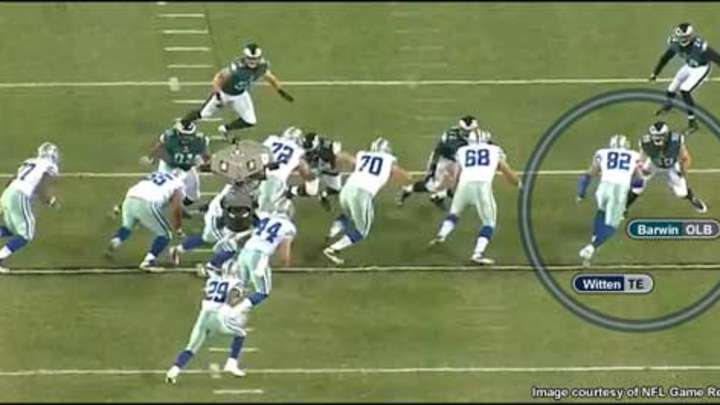
Everything in the greater Dallas area seems to be located near a major highway yet still off the beaten path. Valley Ranch is no different. To reach it, you wind your way through sprawls of developments, both commercial and residential. Most of it is relatively new, but not the landmark that spawned the neighborhood’s growth.
The Dallas Cowboys’ headquarters was built in 1985. It’s no dump, but it’s also not what you’d expect for the franchise that plays in Jerry World. The parking lot is small, the façade a little faded. Next year, the complex will be gone; the Cowboys are moving to Frisco, about 30 miles north.
Enter through the doors, however, and the milieu transforms from dated to historic. Glass-enclosed cases house memorabilia throughout the lobby. Each Cowboys Sports Illustrated cover from the last few decades hangs on one wall. There is a round display case in the middle of the room, where you’ll find a widescreen TV on one side and the club’s five Super Bowl rings on the other.
I peruse the lobby for a few minutes before Rich Dalrymple, the club’s longtime director of public relations, greets me and ushers me through a door in the far corner. We’re heading to the main offensive meeting room, which, he says, is a bit of a walk.
Around every corner there seems to be a new cluster of young people. Not all of them are with the Cowboys, I learn. EA Sports is in today, producing Madden 16. In one particularly high-traffic area, I spy an all-blue room through a window. A lone stool sits in the middle, surrounded by gadgetry that seems to be not of this world. At the moment, the players are on the practice field, enduring 90-degree heat and 74 percent humidity.
After practice, every few minutes, a player in a sparkling game uniform will emerge from the locker room and be chaperoned into the blue room. The locker room sits in the middle of the main corridors and meeting rooms. It is unenclosed around the top, and sound carries out. Snippets of Montell Jordan’s smash hit “This Is How We Do It” keep rising up and filling the air. The instrumental part is a recording, but someone is singing live.
Soon, Montell Jordan himself emerges, dressed in all white, a glitzy chain dangling from his neck. To the players and staffers, Jordan’s presence seems unusual but not extraordinary. This is, after all, one of professional sports’ most glamorous franchises.
“This Is How We Do It” came out in 1995, the last year of the Cowboys’ early-90s dynasty. A grade-schooler at the time, I was a zealous fan of both singer and football team. (I long ago became a neutral observer.) The night before visiting Valley Ranch, I decided to kill an hour visiting the old Texas Stadium site. On the drive there, a part of me somehow forgot that the venue had been demolished in 2010. Now, even the roads leading in felt ghostly. Overlooking the vast expanse of nothingness, my heart panged. Is this what it’s like to feel old?
In a way, a yearning for yesteryear brought me to Texas in the first place. I’m here to watch film with Jason Witten. In an era of lithe, former basketball-playing flex tight ends, Witten is a relic. He wears pads on both forearms. He blocks with precision and alacrity. He runs effectively but not with much explosion or grace. He has the demeanor you’d expect from a native of Elizabethton, Tennessee (population: 14,000). He is, in other words, what tight ends were like when Montell Jordan was making hits.
Witten is coming off the 10th Pro Bowl of his 12-year career. I wait for him in the offensive assembly hall. He enters alone, no PR staffers or assistants in tow, and enthusiastically greets the room. Settling into a first-row seat and running a microphone up his shirt, he comments on the heat outside as our video crew completes its setup. Soon, cameras roll. It’s all football from here on out.
* * *
We’re watching Dallas’s Week 15 game from last year at Philadelphia. “It gets your juices flowing a bit when you play on the road,” Witten says. “Especially in a place like Philly. Their stands are right off the end zone, so their fans are chirping a little bit.”
On the game’s second snap, we see a DeMarco Murray zone run to the right. Witten successfully blocked outside linebacker Connor Barwin. “Yeah, I mean, this is kind of our bread and butter,” Witten says. “Last year this was our identity as a football team with the wide zone scheme, which is what we’re doing [on this play]. It’s not so much about movement as it is about displacement.
“Barwin is one of the best in the league at playing contain. My job is simply to get him off his landmark, and the neat thing about the wide zone is it can hit outside like a sweep, it can hit off-tackle, or it can hit weak side. And so it’s about displacement.”
Barwin needed to be moved outside of the field numbers. Mission accomplished.

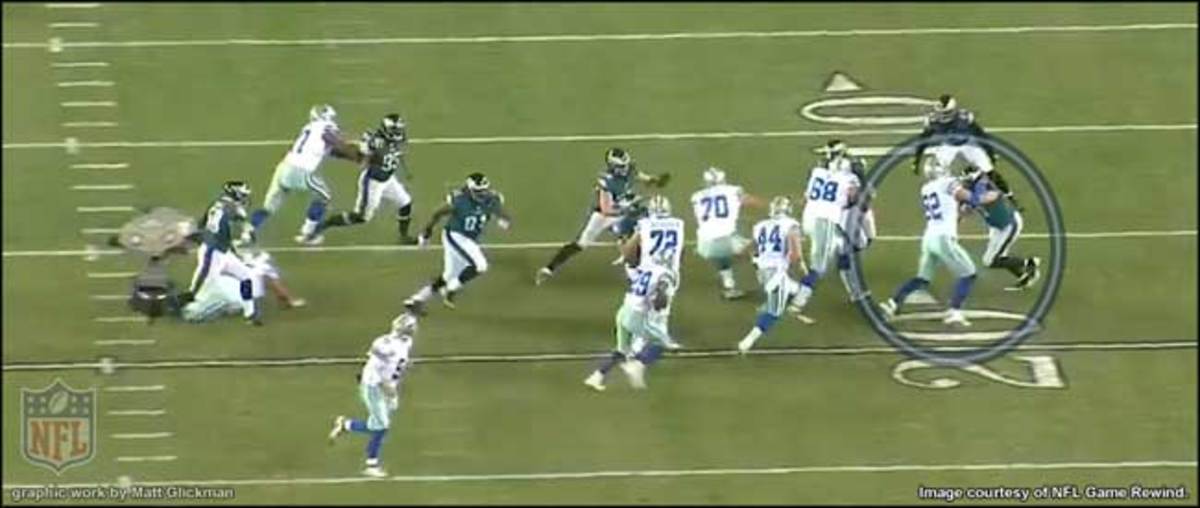
Recall that when Witten entered the league as a third-round pick, in 2002, analysts (including John Madden) zeroed in on his blocking as a point of concern. He was politely described as a “work in progress.”
Now Witten is one of the premier run-blockers at his position. “I did kind of learn the hard way,” he says. “Like most tight ends I was a pass-receiving tight end coming into the league. I learned real quick from [Bill] Parcells that if you want to play in this league and be consistent, you better learn to block. And not just block on the back side and just kind of get in the way; you better be able to block at the point of attack.”
Parcells was “constantly teaching, he was very direct. And there was nowhere to hide. He wanted smart football players, so you had to learn the protections and know what everybody’s responsibilities were on plays. He demanded a lot, and I’m so glad I got to play for him early, because it taught me the fundamentals and expectations of being a consistent tight end. I had a long way to go, but he was the first one to kind of ingrain that in my mind.”
On the next play, Witten is detached from the formation, alone on the weak side, with the running back offset to his side. This is an increasingly popular formation across the NFL. “The biggest reason why we like it,” he says, “is it declares the defense. Especially in the red zone.”
In this instance, cornerback Bradley Fletcher is still aligned on Witten’s side. That indicates zone. (If it were man coverage, Fletcher would have followed one of the wide receivers over to the other side and there would be either a safety or a linebacker on the tight end.)
With safety Malcolm Jenkins having walked over to Fletcher’s side, the Eagles are in a quarters coverage look; each defensive back has a fourth of the field. “When I see this coverage, I immediately know I’m kind of out of the read,” Witten says. By the default rules of Quarters, the safety and corner essentially double Witten. “They’re really going to bracket Dez and me, and we have to move on in the play. That’s where Tony [Romo] does such a great job, getting through his reads and getting to the next play.” With the double-teams declaring the coverage—post-snap, it wound up being Quarters to Witten’s side and man-to-man on the other side—Terrance Williams got matched against an out-leveraged cornerback underneath. Romo hit him for a chains-moving gain of eight.
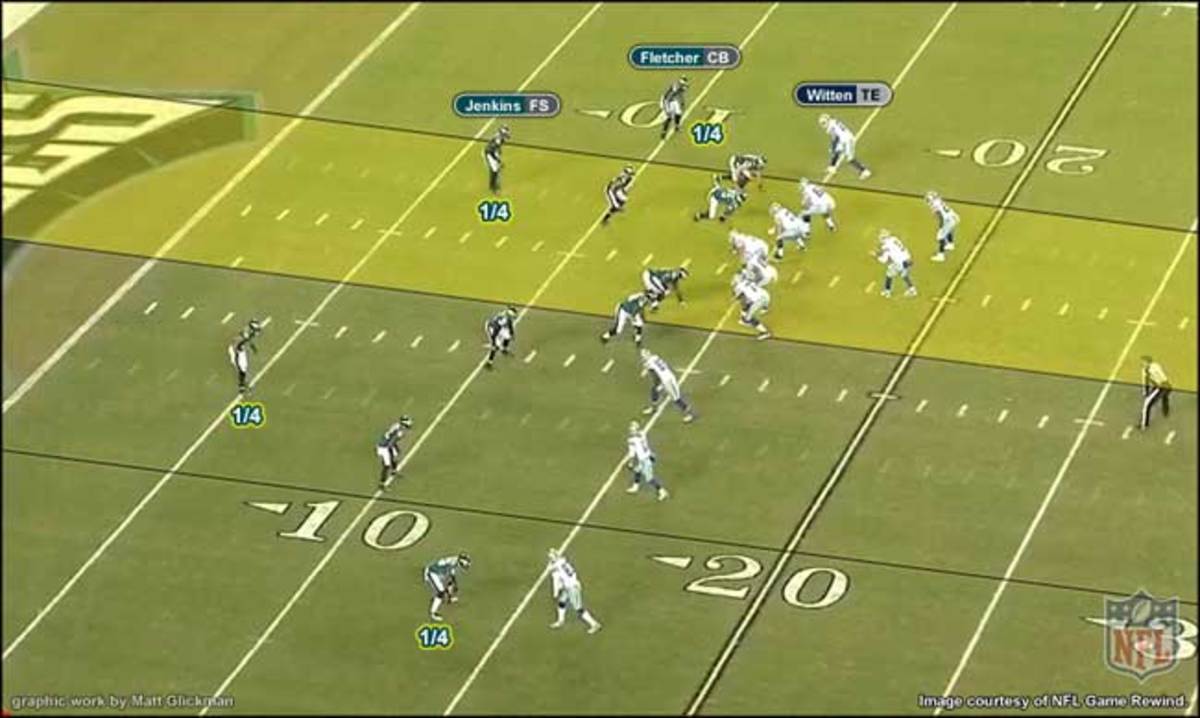
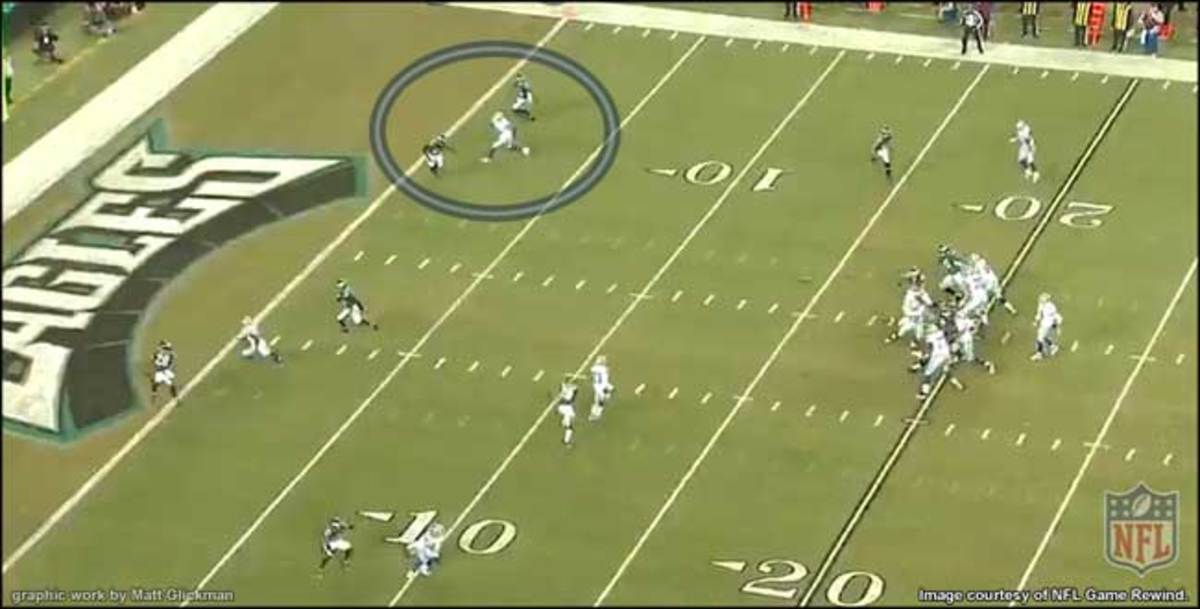
Early on the next series, the Cowboys aligned in a spread 2 x 2 set and ran mirroring route combinations on each side.
Says Witten: “This is just a three-step drop-back. Most of the time, for the quarterback—and Tony does a great job of it every year—it’s pick a side that you like and work it. Here, it really looks like it’s going to be outside leverage for Dez, and you’re going to work that. And Dez wins on the route.”
He beats the corner, anyway. Unfortunately, linebacker Casey Matthews dropped back perfectly to take away Bryant’s slant. “Tony’s really good, he can flip and go to the other side. Most of the time in quick protection, you don’t have time to go back to the other side.”
Romo found a way, but by then the timing of the play was off and the ball was heaved out of bounds. Williams and Witten had both been open, but there was no indication before the snap that this would be the case.
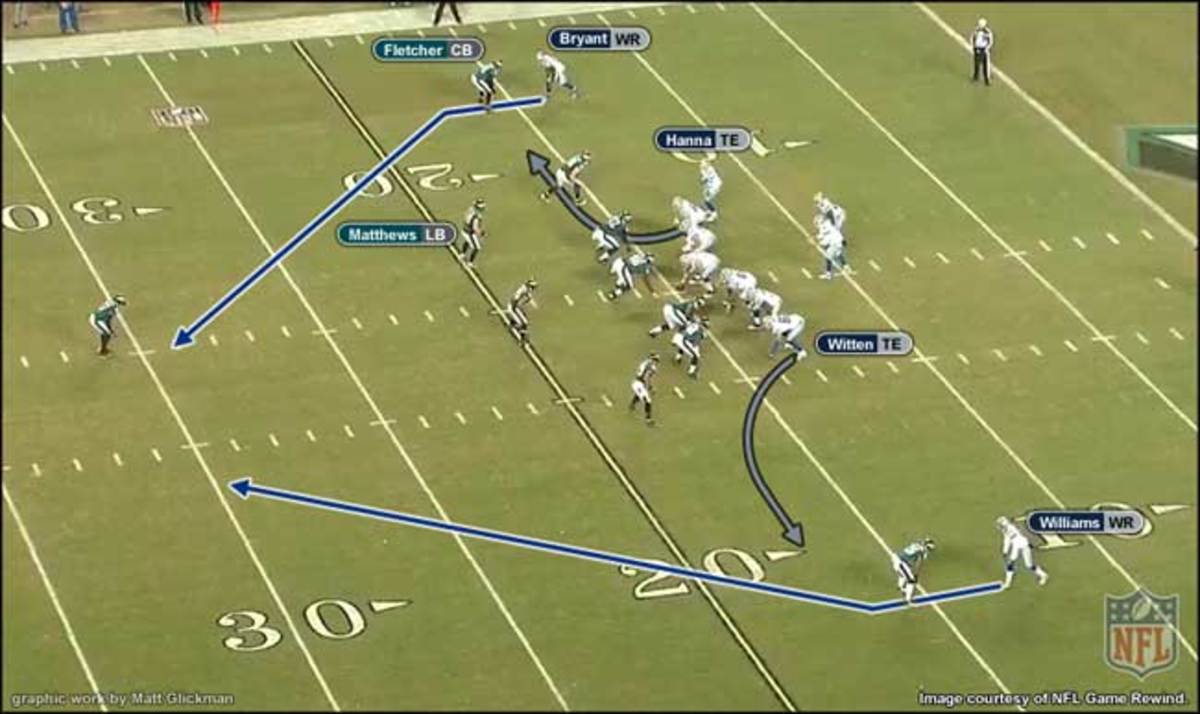
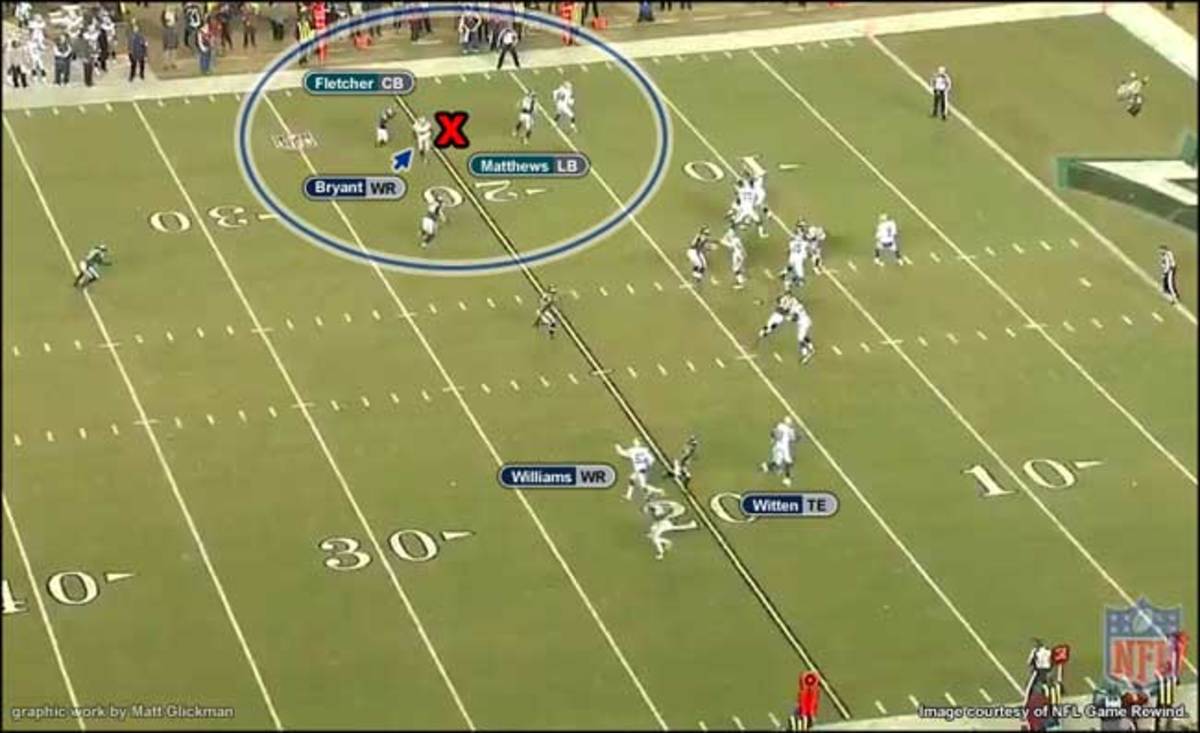
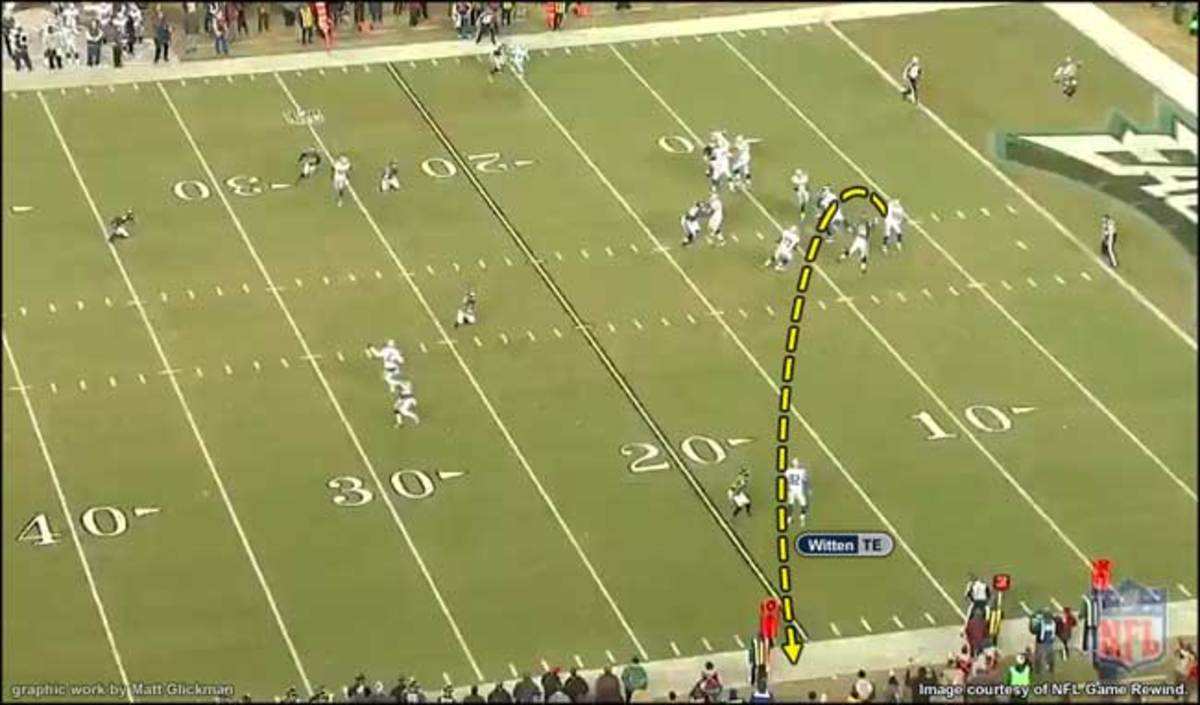
“There will be communication [after this play],” Witten says. “Tony will initiate that. He’s got a lot going through his mind, so on a three-yard flat route, I don’t know that I’m running over to him and saying ‘Hey man, I got this guy off coverage, you can really hit me in the flat.’ But Tony will constantly say ‘Hey, Terrence, Witten, who’d you have over there?’ And we’ll say, ‘Yeah, my guy was off, probably could have had it inside.’ But when you’re in quick-game (i.e. a three-step drops), the quarterback’s picking a side. A lot of times when he sees one-on-one with Dez, that’s a great matchup, obviously, in any situation.”
That incompletion set up a third-down-and-7, which Witten converted with a 21-yard reception. He was aided by a formation that confused cornerback Nolan Carroll and out-leveraged cornerback Brandon Boykin.
“We love getting in a stack [alignment], for a couple of reasons. One is that third down is a high man-to-man coverage for Philadelphia. We had played them at home on Thanksgiving and they got in our face and played man-to-man and really got after us and had success. So going into this game we knew they were probably going to try to play man. And why wouldn’t they? They kind of controlled the game [the last time].”
With Witten and Cole Beasley aligned so close together, Carroll and Boykin had to back off and play the receivers’ releases. Carroll would take whichever receiver went inside and Boykin would take whoever went outside. The problem for Philly was that Witten’s and Beasley’s routes did not declare inside and outside very quickly.
“Beasley is fantastic in the slot versus man-to-man. He’s reading this coverage, too. If [Carroll] carries me here, and [Boykin] stays low and pulls, Beasley’s going to come open. That was a great call by [offensive coordinator Scott] Linehan to get us in the stack and see how it plays out. Ideally, we feel like that’s a matchup where we can’t lose, however they play it.
“And really, we’re running that route to get Beasley isolated on a man coverage. I’m going vertical, Tony does a great job of getting through his read and sees, ‘Hey, they didn’t carry Witten here, it’s a great opportunity to hit a ball right down the seam.’ ”
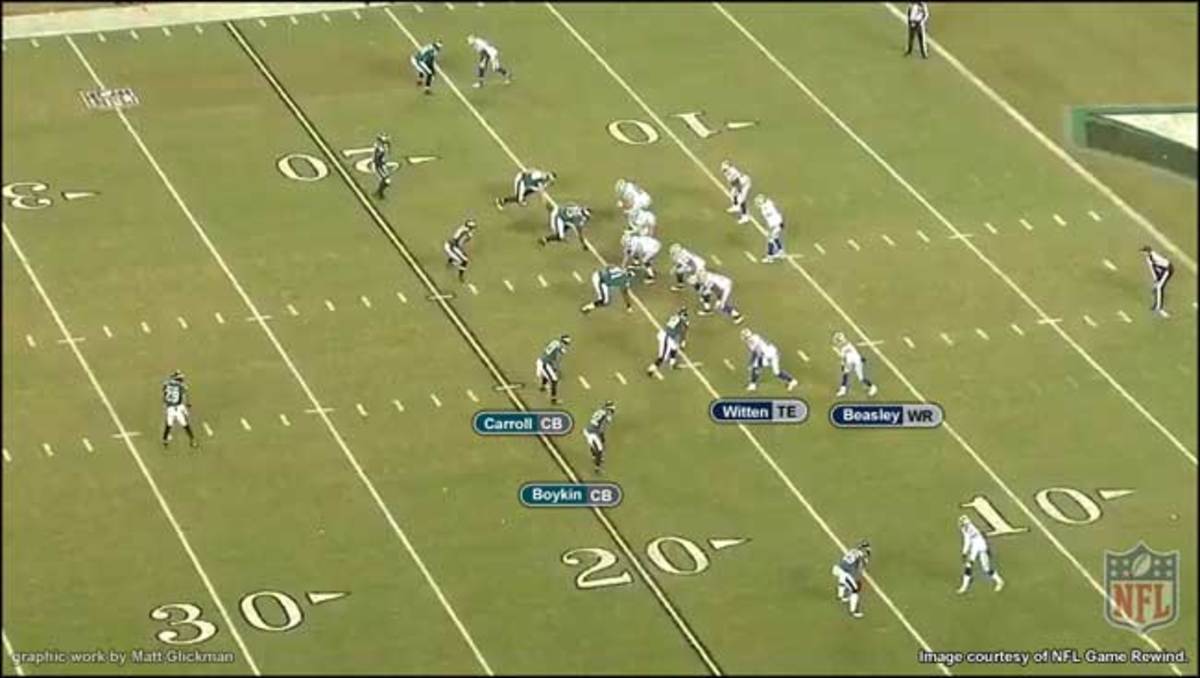
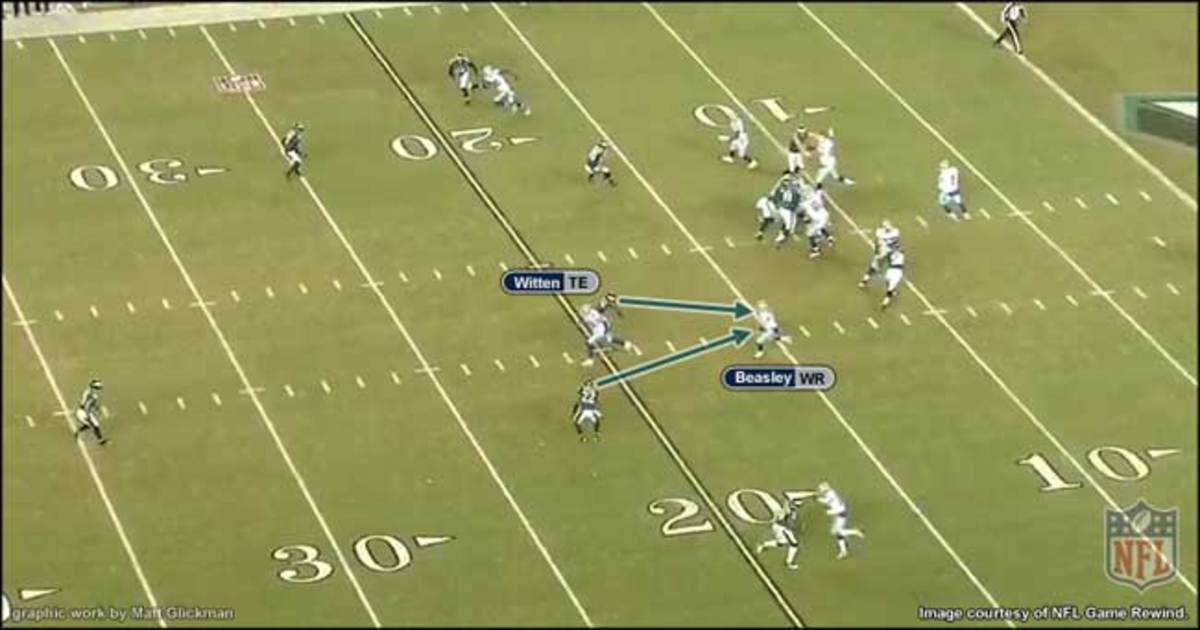
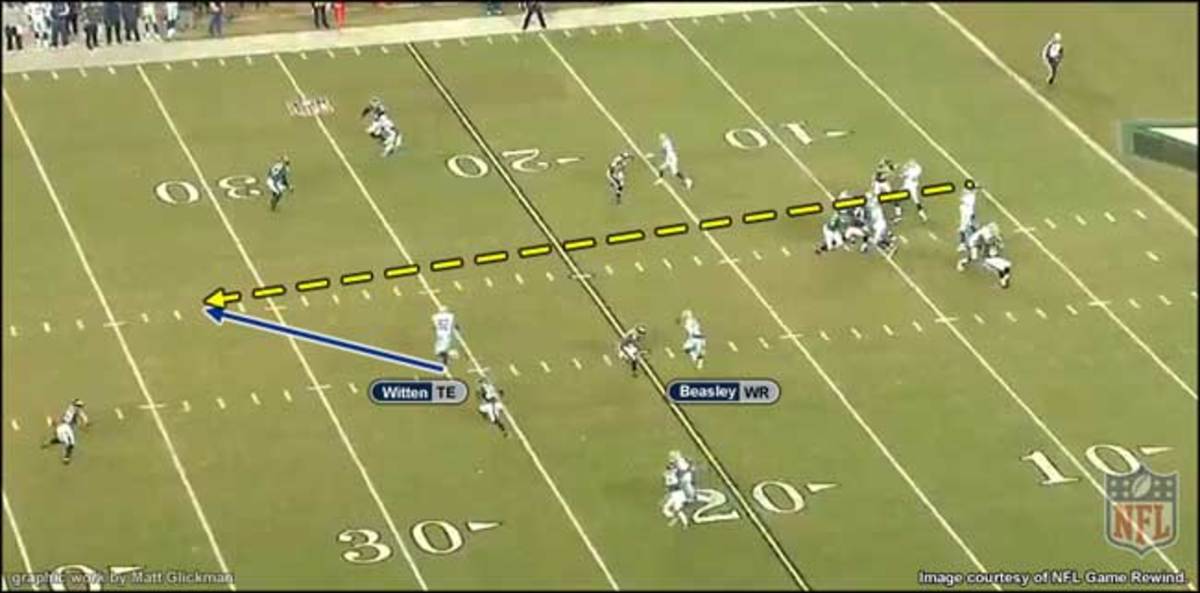
This was the first of three third down conversions Witten had on the drive. The next was a 17-yarder on third-and-5 against a blitz, which the veteran easily recognized before the snap. The defender over him, Mychal Kendricks, would rush, which meant safety Malcom Jenkins was the man to beat on the play.
It’s a blitz indicator “when safeties are stacking linebackers,” Witten says. “Kendricks is just trying to hide it, pretending as if he’s covering, but he’s going to blitz. The Eagles like to play Cover 1, five-man rush.” Kendricks was that fifth rusher. “The tricky part here is, I knew I was running this route on Jenkins, but he’s [guarding the first down sticks]. It made it tough because I had to push up for depth, and then get across.”
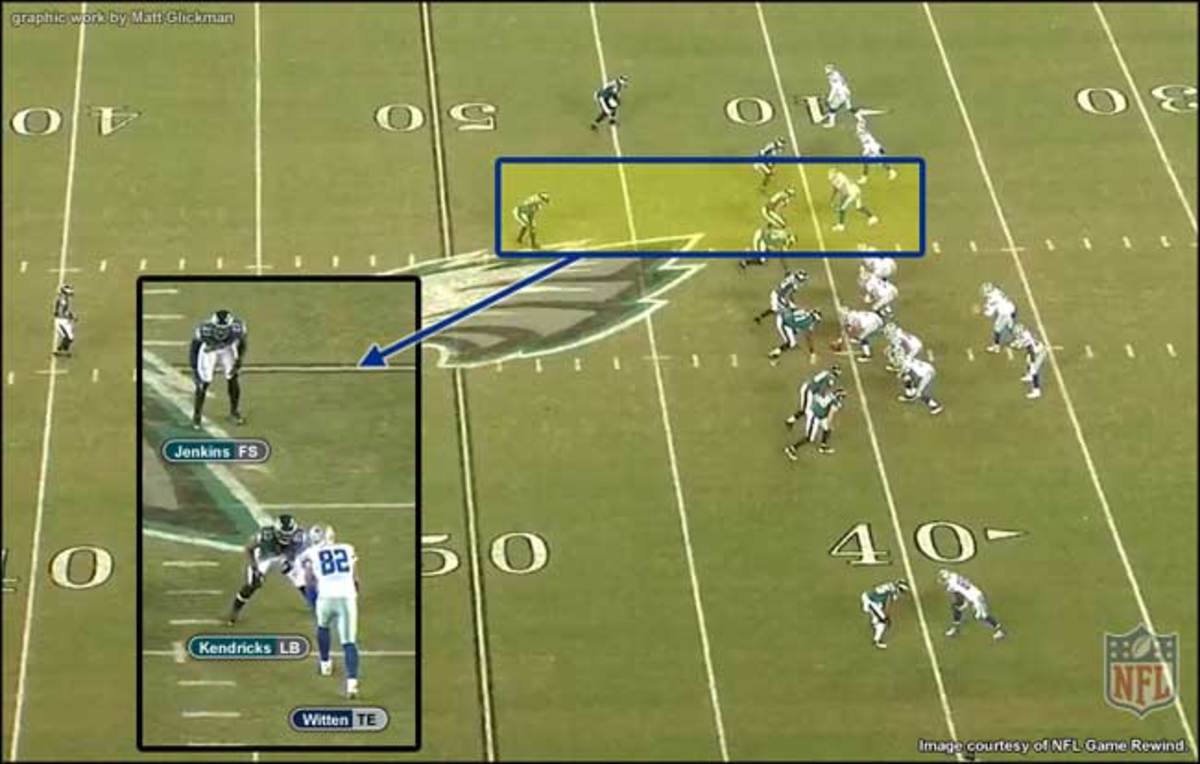
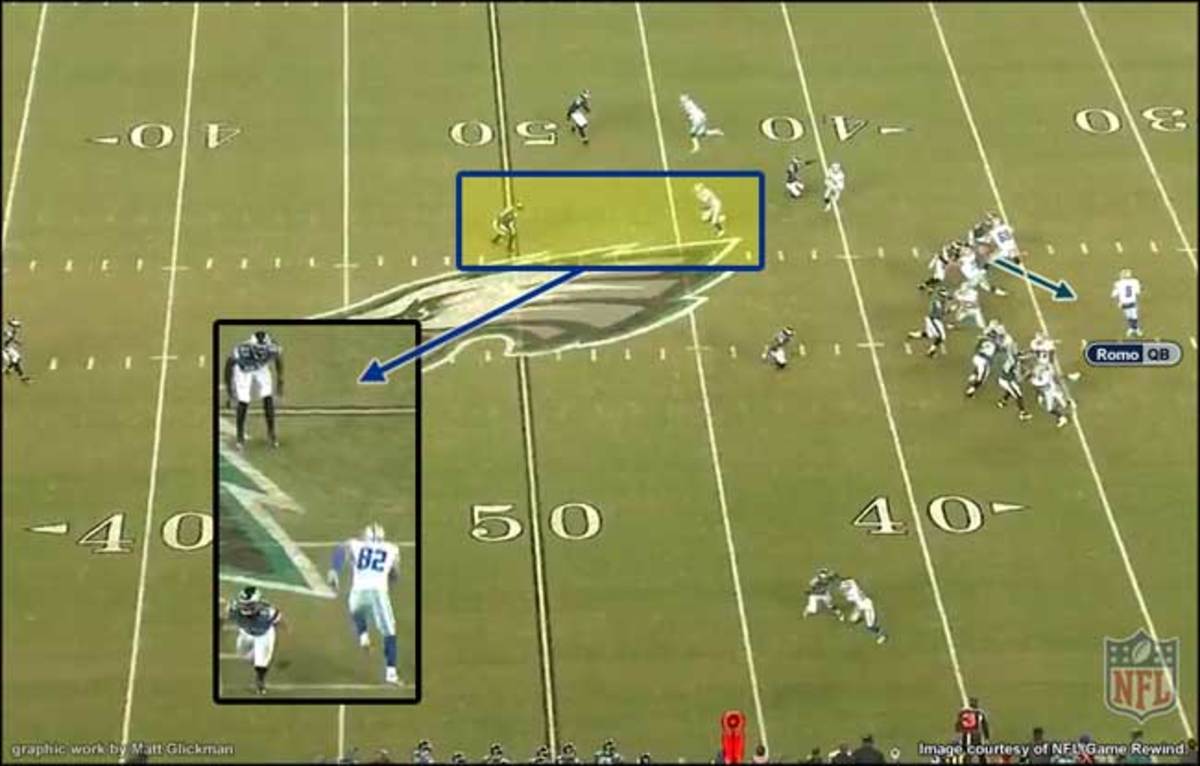
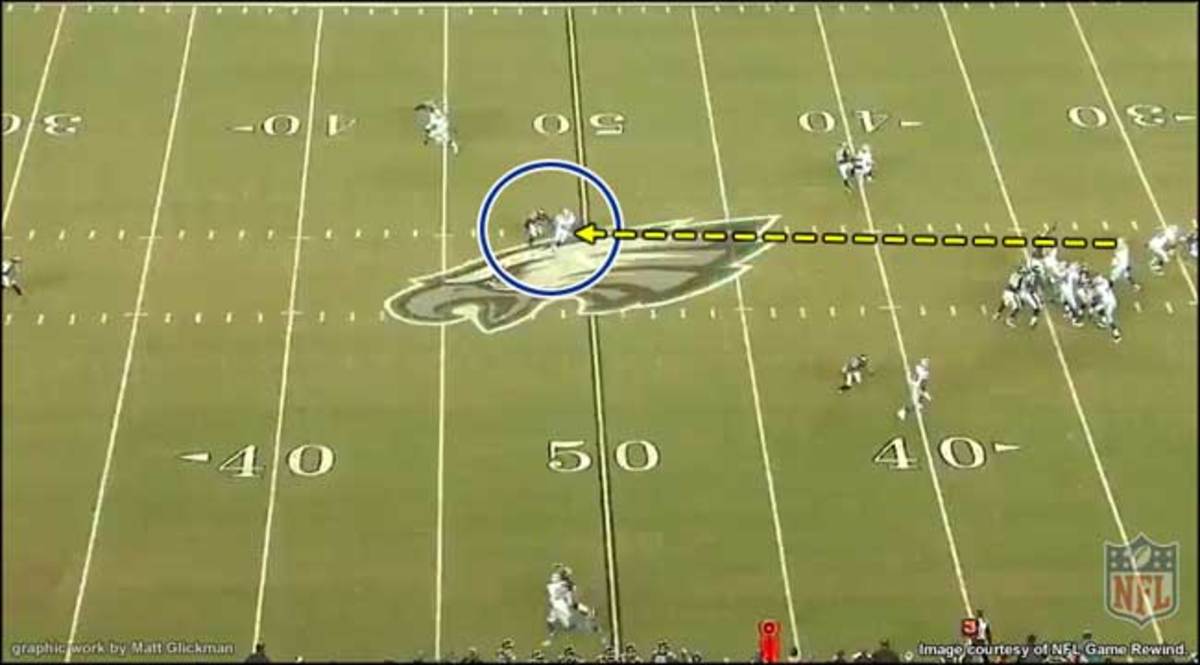
Even if a tight end diagnoses the coverage like this, facing a safety in space can be difficult. “Ideally, if you ask most tight ends, they would say we want the defender on us early. The reason for that is we feel like, for one, we know where we’re going. Two, we can attack leverage, it declares itself if it’s truly man coverage. We can work the release. And if you can work the release, you can keep him outside, get a lean [on him] and then you’ve got an opportunity to run after the catch. When a defender’s playing seven, eight yards off the ball, at some point there’s going to be a collision. You don’t really get to work him in the route, because he’s playing high to low instead of low to high.”
The next successful conversion was a four-yarder on third-and-3. It was a gimme completion thanks to a short tight end shift presnap that forced the Eagles to declare their man coverage. (Defenses almost always play man coverage on third-and-short; in this case, the shift out-leveraged the man coverage.) The shift, Witten says, was built into the play design.
It’s wasn’t all roses for Witten on this drive. A few plays later, he missed on a run-block against Casey Matthews. His mistake didn’t impact the play because right guard Zack Martin also whiffed, allowing defensive tackle Fletcher Cox into the backfield for a two-yard loss.
On this run design, Witten was technically supposed to help left tackle Tyron Smith double-team defensive end Cedric Thornton and then work up to the linebacker. But Thornton aligned so far inside that no double was needed.
“As soon as I see Tyron’s on it, I should be squarer and just climb to [Matthews],” Witten says. “When you climb to the second level, you have to eliminate space, and what I did a poor job of here is I didn’t take the space out of the block, even though Matthews ran around. [His running around], in theory, should make my job easier, so I should just turn and kick him out and eliminate him from the play. If I lose to him, I want to lose him on the outside, because it’s an inside play.”
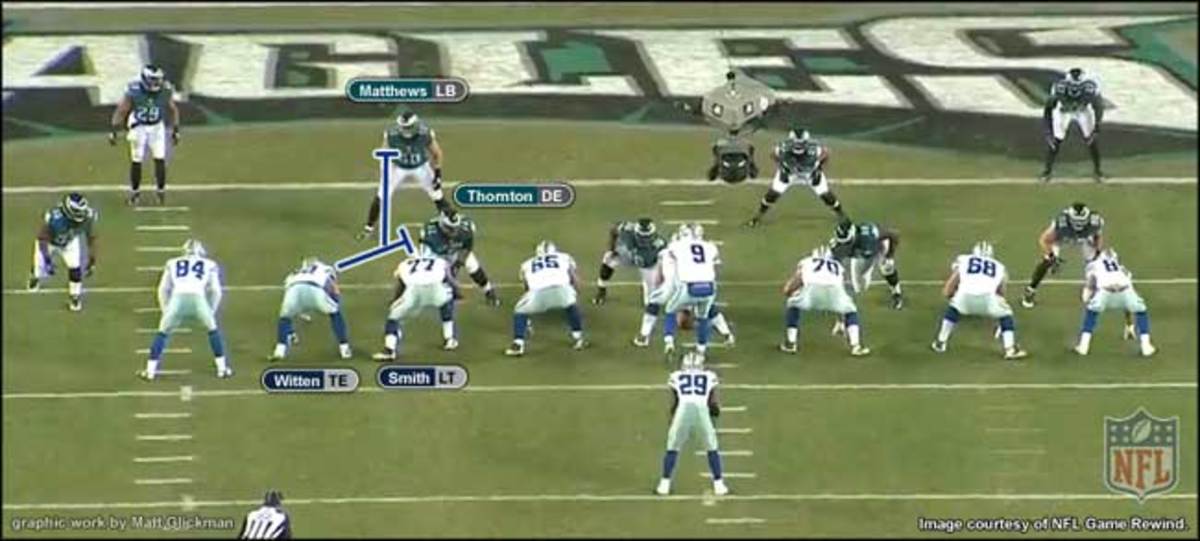
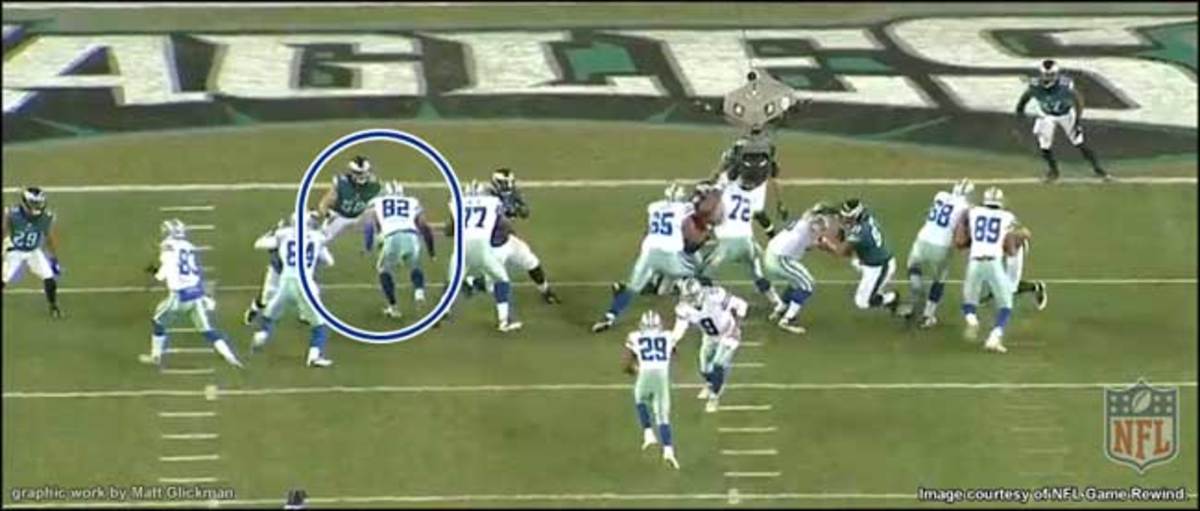
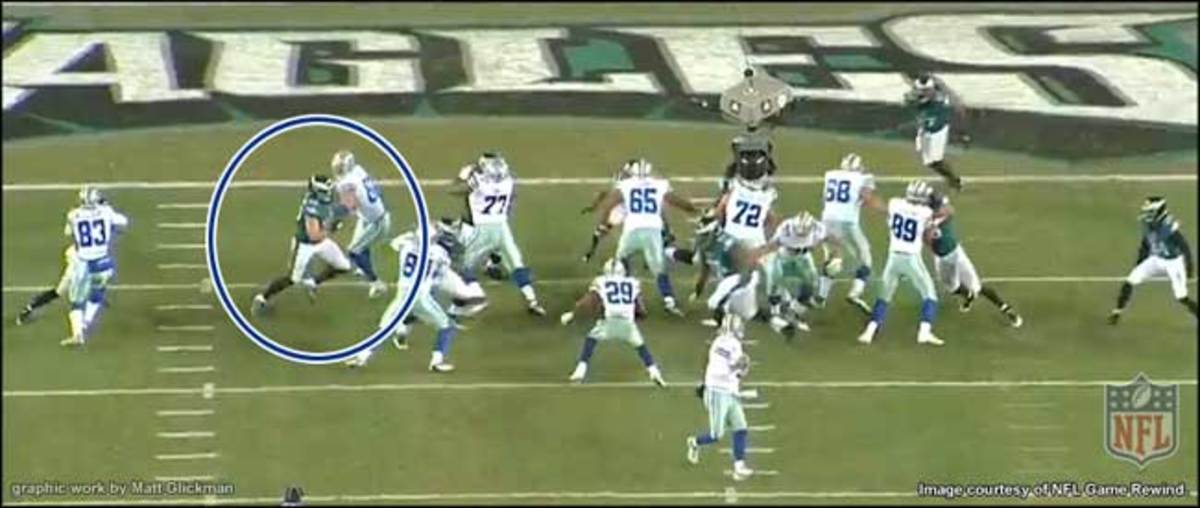
Witten had another negative run block on the next series. He was called for a hold. If the official had any doubt, Witten himself probably eliminated it by immediately turning around and looking for a flag. “That wasn’t a veteran move, turning around with the head that quick,” he says. “But I think a lot of times, they just see the guy go down, and they assume that’s holding. [The official] doesn’t see that [the defender] kind of tripped on his own guy. But this play, I had a tug in there for sure. Definitely a rookie mistake by looking back at the ref.”
Early in the third quarter, we see that the Eagles made a shrewd halftime adjustment against the Cowboys’ zone running game. They shifted their defensive line so that end Cedric Thornton was aligned over the tight end instead of the offensive tackle. This allowed Thornton to go one-on-one against Witten. Thornton has about a 50-pound advantage.
“If you remember, going back earlier, the play we saw with Tyron and I, Thornton was over Tyron, so we were doubling up to the linebacker. Now we’re running the same play to the other side, but now it’s two available holes; last time was three holes. [The Eagles] got smart and adjusted, as all good defenses do.
“Ideally, if you asked my coach, he would say, ‘Hey, we expect to get a stalemate in these positions.’ So right there when I got Thornton, I kind of miss with my right hand. So he’s able to get his hands inside, and of course he’s a bigger, stronger guy. But if we could have stalemated—rewind it just a little bit, to this point right here . . .” The film freezes and we see Witten’s feet being lifted off the ground. “There’s the hole.”
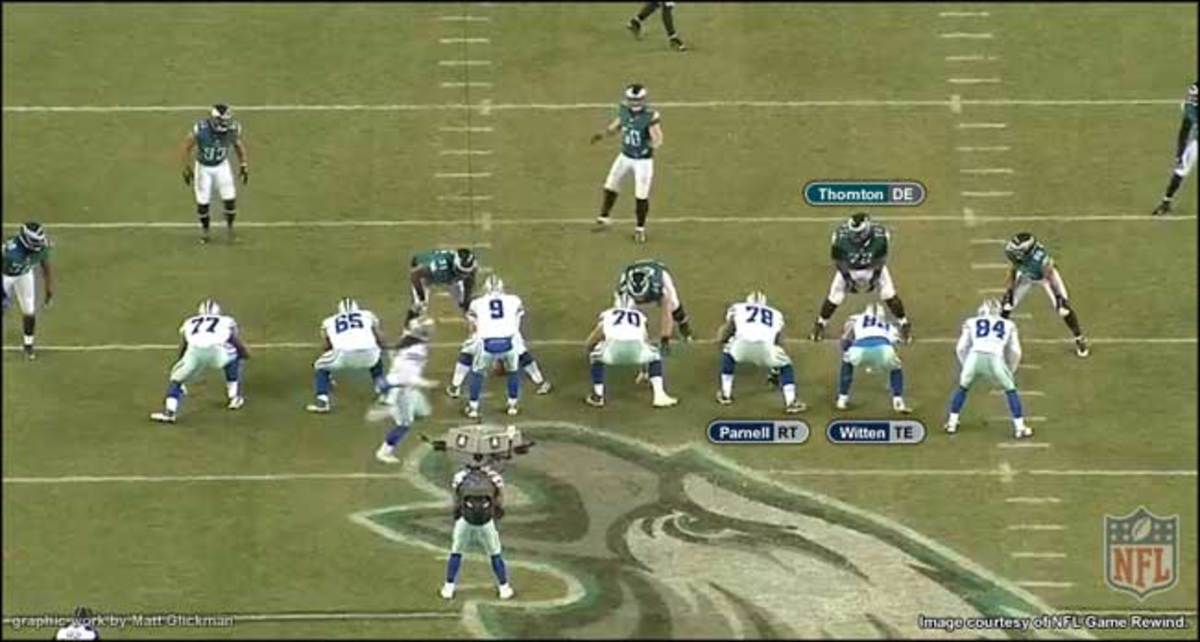
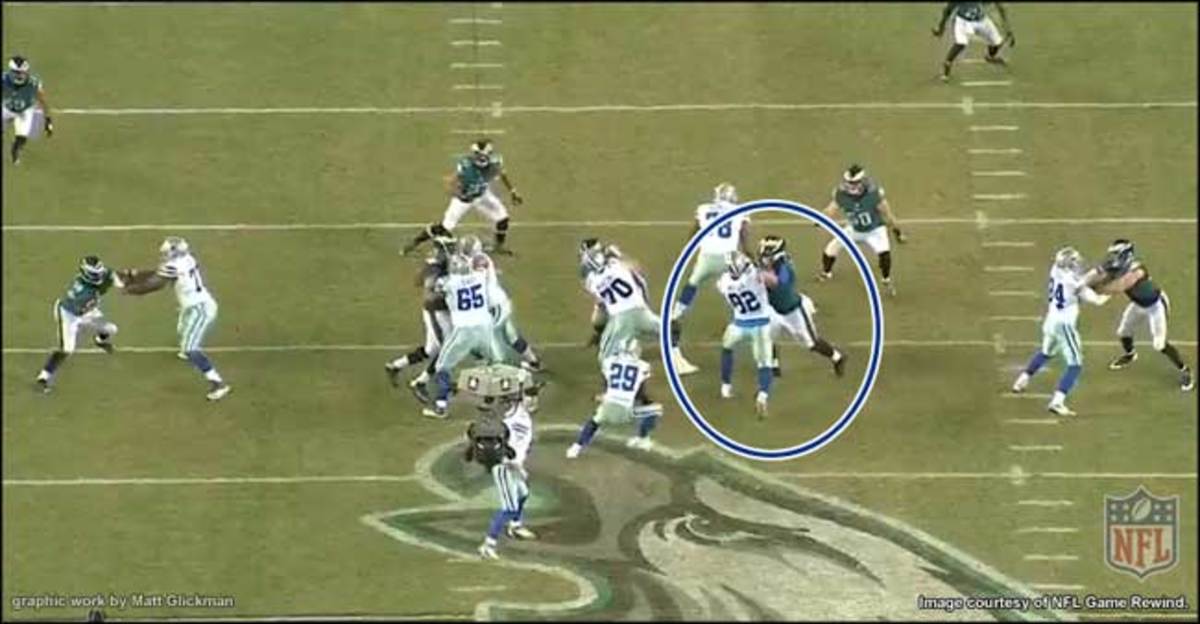
I ask Witten who’s the toughest guy he’s ever had to block.
“Oh, I would say Michael Strahan. He was physical, he was strong, but he was explosive, too. He can go through you, he can go around you, and he’s quick enough to go inside or outside. I think that’s what makes J.J. Watt really good. He has the quickness to do all three, and the power to go through you as well, so it keeps you guessing. That’s what makes it tough. Strahan was really, really good at that.”
Late in the third quarter Witten catches an 11-yarder on an out-route against Connor Barwin. “This is a huge play for us. I mean it’s first-and-10, a drive-starter.”
It helped that Witten drew such a favorable matchup. “Connor’s a great player, but ideally, he’s a rusher coming off the edge, he’s a run-stopper,” Witten says. “If there’s an area we can try to get him, it’s out in space and in coverage; that’s what we want to try and do.”
A guy you don’t necessarily want to face in space, especially if you’re run-blocking, is Barwin’s fellow linebacker Mychal Kendricks, who plays inside. That’s precisely the challenge Witten faces midway through the fourth quarter on a second-and-5. Lance Dunbar gained four on the play; if not for nose tackle Bennie Logan shuffling down the line of scrimmage, Dunbar would have ran right off of Witten’s block and into the open field.
How different is it blocking an athletic target in space versus someone who is up on the line of scrimmage?
“In space, you don’t know where the ball is going. So a lot of times it becomes tricky because the defender is seeing it, so he can stop and cut back, he can run right through you, he can avoid outside. You have to eliminate the space as quickly as you can. Again, it’s about displacement, it’s not about vertical movement, so we can take the linebacker and go past the [field] numbers and that’s what makes this zone scheme work.”
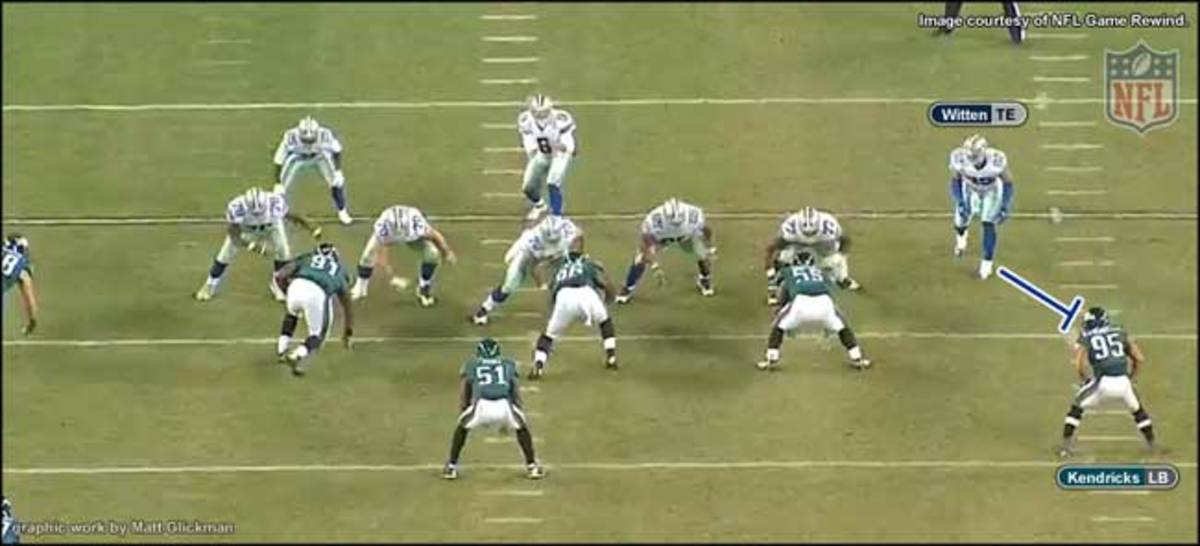
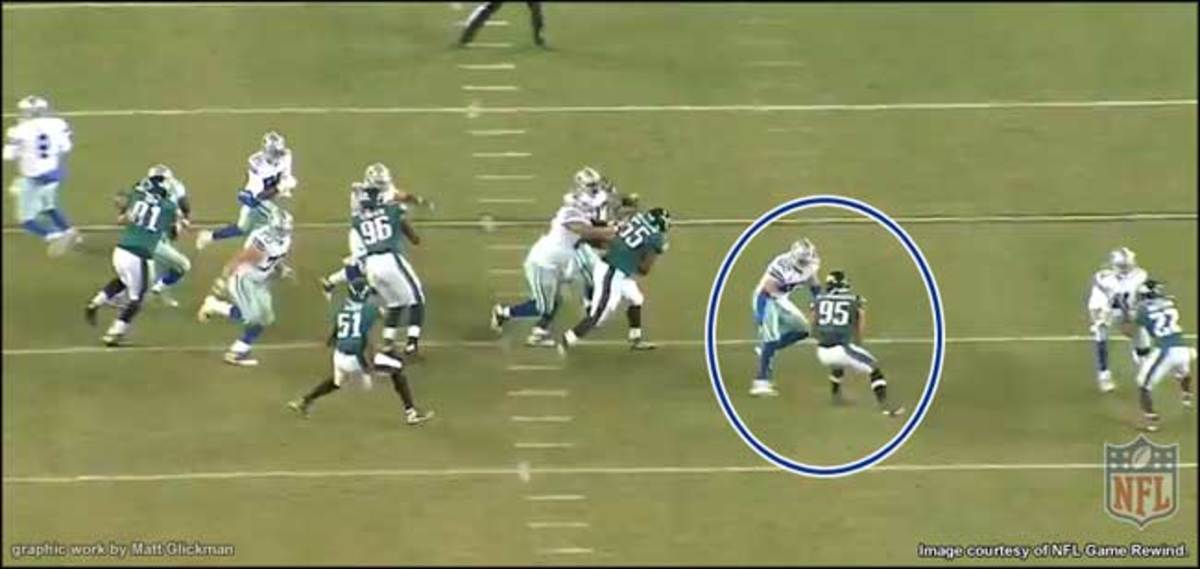
What’s most apparent throughout our visit that Witten is fully ensconced in his quarterback’s corner. Much of what he says is peppered with praise for Romo. I realize the full extent of this loyalty on the final play that we break down. A DeMarco Murray holding penalty ultimately negated the whole thing anyway, but Romo fired a pass to Witten, who was running a short hook against Matthews. They’d connected on a very similar scenario earlier. This time, though, Romo threw the ball two feet too low and a yard behind his tight end. The grossly inaccurate pass was almost comical because Romo had time to wind up and deliver. If this were a golf shot, the divot may have traveled further than the ball. These things happen, even to QB’s with a 69.9 completion rate.
Ultimately, Witten acknowledges this. But not without also saying: “He doesn’t miss on his throws very often; he’s done a great job of making us look good as receivers, and especially me as a tight end; very rarely does Tony miss; he did a great job getting off [the Beasley read on the other side] and coming back [to me] late.”
Witten genuinely has his quarterback’s back, another trait that makes him one of the game’s great veterans.
• Question or comment? Email us at talkback@themmqb.com
